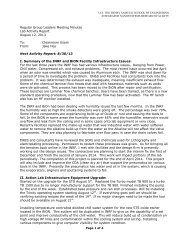Download Lab Safety Manual - Integrated Nanosystems Research ...
Download Lab Safety Manual - Integrated Nanosystems Research ...
Download Lab Safety Manual - Integrated Nanosystems Research ...
You also want an ePaper? Increase the reach of your titles
YUMPU automatically turns print PDFs into web optimized ePapers that Google loves.
These chemicals are all flammable solvents with low flash points. This means that at sufficiently high vapor<br />
concentrations, they can easily be ignited at room temperature and, therefore, pose significant fire hazard. Thus,<br />
solvents should not be used on or near hot plates, or near any electrical system. Solvents may also ignite or<br />
explode when brought into contact with chemical oxidizers (such as many acids) and should not be mixed with,<br />
nor collected in the same waste container with these compounds. Standard solvent waste should be disposed of in<br />
the solvent collection tank.<br />
These and other solvents must be stored in the designated flammables cabinet with in lab and may be transported<br />
in the lab only to designated wet benches and hoods.<br />
‣ Chlorinated Solvents<br />
Chlorinated solvents (such as chlorobenzene, and methylene chloride) may be present in some special resist<br />
processes, although these have largely been phased out of general use. Long term, repeated exposure to some<br />
chlorinated solvents is correlated to cancer and liver and nerve damage. Because of environmental hazards,<br />
chlorinated solvent waste must be collected in a waste container, separate from other kinds of liquid solvent<br />
waste.<br />
‣ Glycol Ether Solvents<br />
Glycol ethers are solvents that may be present in some photoresists. These compounds have been implicated in<br />
reproductive problems, including possible miscarriages in semiconductor workers. INRF/BiON has phased out<br />
glycol ethers from the main line, standard photoresists. However some specialty photoresists used by some<br />
researchers may contain some glycol ethers.<br />
Glycol ethers may be referred to generically as “Cellosolve”, but the following names also refer to glycol ether<br />
compounds: Methyl Cellosolve, 2-methoxyethanol, Ethyl Cellosolve, 2-ethoxyethanol (2EE), Ethylene glycol<br />
mono ethyl ether. Acetate salts of glycol ether compounds may also appear in some specialty photoresist<br />
formulations as: Cellosolve Acetate, Ethyl cellosolve acetate (ECA), Ethylene glycol mono ethyl ether acetate, 2-<br />
Ethyoxy ethyl acetate.<br />
Environmental monitoring studies done at UCI indicate that there is no risk of significant exposure of these<br />
compounds, as long as handling of photoresists takes place only in designated exhausted work areas. As a<br />
researcher, your responsibility is to always observe proper chemical handling practices, and to make sure that the<br />
people working around you also do so as well.<br />
6.2 Oxidizers<br />
‣ Peroxides<br />
All peroxides are highly oxidizing materials. Considerable energy is released when they are reacted. Some<br />
peroxides are unstable and can explode. 30% hydrogen peroxide in water is stocked in the lab. Extreme care<br />
should be used in mixing solutions containing peroxides. Peroxides are incompatible with all forms of organic<br />
solvents and flammable materials.<br />
‣ Sulfuric acid and “Piranha” clean<br />
The heated mixture of concentrated sulfuric acid and 30% hydrogen peroxide is commonly referred to in the<br />
semiconductor industry as “Piranha clean”. This mixture is an extremely aggressive oxidizer, used primarily for<br />
removing photoresist and, in sequence with other chemical mixtures, to remove contaminants (i.e., the “RCA” or<br />
pre-diffusion clean process). The proportions of sulfuric acid and hydrogen peroxide used will depend on the<br />
particular wet bench and application.<br />
The piranha solution self-heats when mixed and immediately destroys organic materials it contacts (photoresist,<br />
clean room wipes, vinyl or latex gloves, skin). Piranha vapor is extremely caustic, so the piranha mix should be<br />
used only under an exhaust hood. Boiling piranha spatters, so always wear protective gear when working over a<br />
hot pot. Piranha is incompatible with all solvents and flammable materials. It reacts violently when mixed with<br />
base. Do not add water directly to piranha to try to cool it; sulfuric acid is water reactive, so adding water will<br />
cause heating (not cooling) and can lead to an explosion.<br />
17



